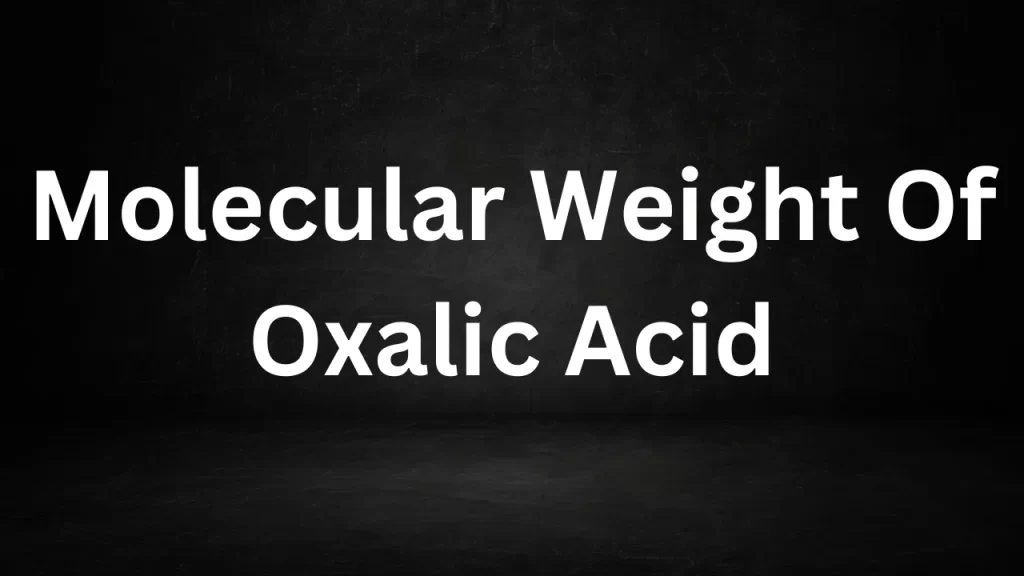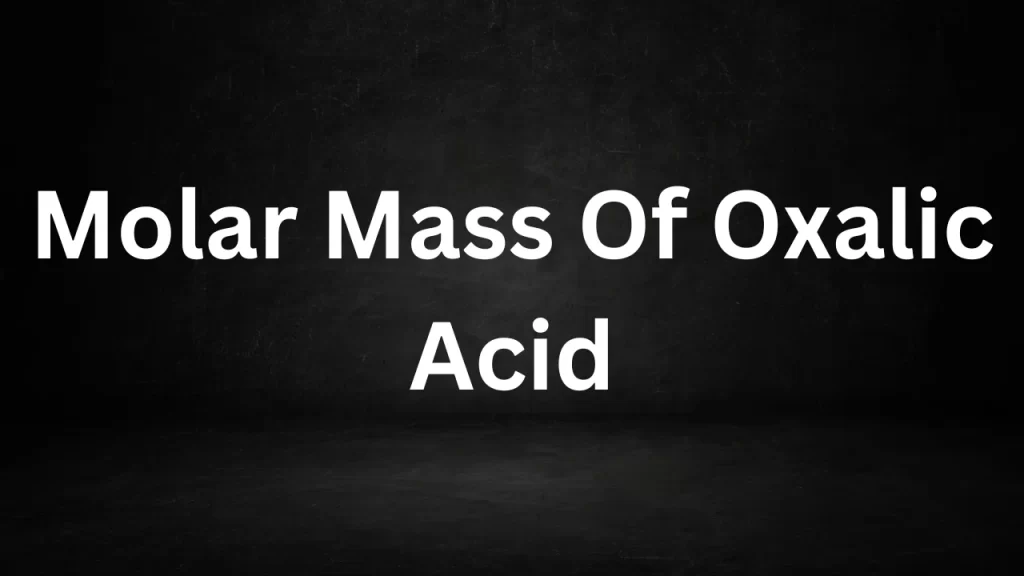Tag: molar mass oxalic acid dihydrate
Molecular Weight Of Oxalic Acid
Molecular Weight Of Oxalic Acid: h2c2o4 is a simple organic compound with the chemical formula C₂H₂O₄.
Understanding its molecular weight is essential in various scientific and practical applications, as it plays a crucial role in chemistry, biology, and environmental sciences.
 Molecular Weight Of Oxalic Acid
Molecular Weight Of Oxalic Acid
Molecular Formula of Oxalic Acid
Before diving into its molecular weight, let’s first look at the molecular formula of h2c2o4, which is C₂H₂O₄. This formula tells us that one molecule of oxalic acid consists of two carbon atoms (C), two hydrogen atoms (H), and four oxygen atoms (O).
Atomic Weights of Elements
To calculate the molecular weight of oxalic acid, we need to know the atomic weights of the constituent elements. As of my last knowledge update in September 2021, the atomic weights of these elements are as follows:
- Carbon (C): Approximately 12.011 atomic mass units (amu)
- Hydrogen (H): Approximately 1.008 amu
- Oxygen (O): Approximately 15.999 amu
Calculation of Molecular Weight
Now, let’s calculate the molecular weight of h2c2o4 by summing the atomic weights of its constituent atoms:
- Carbon (C): 2 atoms × 12.011 amu = 24.022 amu
- Hydrogen (H): 2 atoms × 1.008 amu = 2.016 amu
- Oxygen (O): 4 atoms × 15.999 amu = 63.996 amu
Now, add these values together:
Molecular weight of oxalic acid = 24.022 amu + 2.016 amu + 63.996 amu ≈ 90.034 amu
So, the molecular weight of h2c2o4 is approximately 90.034 atomic mass units (amu) or 90.034 grams per mole (g/mol).
Significance of Molecular Weight
Understanding the molecular weight of a compound is vital for various scientific applications. Here are a few reasons why it’s important:
- Stoichiometry: Molecular weight is crucial for stoichiometric calculations in chemistry. It helps determine the number of moles of a substance in a given mass.
- Chemical Reactions: Molecular weight is used to balance chemical equations and predict the outcomes of chemical reactions.
- Analytical Chemistry: In analytical chemistry, molecular weight plays a role in techniques like mass spectrometry, where it helps identify and quantify substances.
- Pharmacology: In the pharmaceutical industry, molecular weight is essential for drug formulation and dosage calculations.
- Environmental Sciences: Molecular weight is used to understand the behavior of compounds in the environment, including their transport, transformation, and toxicity.
Conclusion
The molecular weight of oxalic acid, a simple organic compound with the chemical formula C₂H₂O₄, is approximately 90.034 grams per mole (g/mol).
This value is essential for a wide range of applications in chemistry, biology, and environmental sciences, making it a fundamental parameter in scientific research and industry. Please note that atomic weights are subject to periodic updates, so it’s essential to consult the most recent values for precise calculations.
Read More
Frequently Asked Question (FAQs) Molecular Weight Of Oxalic Acid
What is oxalic acid?
h2c2o4 is a simple organic compound with the chemical formula C₂H₂O₄. It is a dicarboxylic acid and occurs naturally in various plants, including spinach and rhubarb. It is also used in various industrial applications.
Why is the molecular weight of oxalic acid important?
The molecular weight of a compound is essential in chemistry for stoichiometric calculations, chemical reactions, and various analytical techniques. It provides crucial information about the mass of one mole of the substance.
How is the molecular weight of oxalic acid calculated?
The molecular weight of h2c2o4 is calculated by summing the atomic weights of its constituent elements. In the case of oxalic acid, you add the atomic weights of two carbon (C) atoms, two hydrogen (H) atoms, and four oxygen (O) atoms.
What are the atomic weights of the elements in oxalic acid?
- As of my last knowledge update in September 2021:
- Carbon (C): Approximately 12.011 atomic mass units (amu)
- Hydrogen (H): Approximately 1.008 amu
- Oxygen (O): Approximately 15.999 amu
What is the molecular weight of oxalic acid?
The molecular weight of h2c2o4 is approximately 90.034 grams per mole (g/mol) based on the atomic weights mentioned above.
Molar Mass Of Oxalic Acid
Molar Mass Of Oxalic Acid: The molar mass of oxalic acids, which has the chemical formula C2H2O4, can be calculated by summing the atomic masses of all the atoms in one mole of the compound. Here’s how you can calculate it:

Molar Mass Of Oxalic Acid
Calculating the Molar Mass of Oxalic Acid
To calculate the molar mass of oxalic acids (C2H2O4), we sum the atomic masses of its constituent elements:
- Carbon (C) has an atomic mass of approximately 12.01 g/mol.
- Hydrogen (H) has an atomic mass of approximately 1.01 g/mol.
- Oxygen (O) has an atomic mass of approximately 16.00 g/mol.
Now, let’s compute the molar mass of oxalic acid:
Molar Mass of Oxalic Acids (C2H2O4) = (2 × Atomic Mass of Carbon) + (2 × Atomic Mass of Hydrogen) + (4 × Atomic Mass of Oxygen)
Molar Mass of Oxalic Acids (C2H2O4) = (2 × 12.01 g/mol) + (2 × 1.01 g/mol) + (4 × 16.00 g/mol)
The Molar Mass of Oxalic Acids (C2H2O4) = 24.02 g/mol + 2.02 g/mol + 64.00 g/mol
Molar Mass of Oxalic Acids (C2H2O4) ≈ 90.04 g/mol
So, the molar mass of oxalic acids (C2H2O4) is approximately 90.04 grams per mole.
Significance of Oxalic Acid’s Molar Mass
Understanding the molar mass of oxalic acids is essential for various reasons:
- Chemical Reactions: Molar mass plays a pivotal role in stoichiometry, helping chemists determine the quantity of substances needed and produced in chemical reactions involving oxalic acids.
- Laboratory Procedures: In laboratories, chemists use molar mass to measure and prepare precise amounts of substances, ensuring accurate experiments and analyses.
- Solution Concentrations: Molar mass aids in calculating the concentration of oxalic acids solutions, which is crucial in fields like analytical chemistry and titration experiments.
- Industrial Applications: Oxalic acids finds application in various industries, including textile, metal polishing, and pharmaceuticals. Knowing its molar mass is essential for quality control and production processes.
- Safety Precautions: Understanding the molar mass of oxalic acids is vital for safety considerations in handling, storage, and transportation, as it helps assess potential hazards.
Conclusion
The molar mass of oxalic acids, approximately 90.04 g/mol, may seem like a mere numerical value, but it holds great importance in the realm of chemistry and scientific endeavors.
Read More
- ypes Of Chemical Bonding
- Chemistry In Everyday Life
- Energy Stored In A Capacitor
- Compound Lenses Thin Lenses In Contact
- 12th Class English Book Question Answer Pdf Download
Frequently Asked Questions (FAQs) Molar Mass Of Oxalic Acid
-
What is the molar mass of oxalic acid (C2H2O4)?
The molar mass of oxalic acids is approximately 90.04 grams per mole (g/mol).
-
Why is knowing the molar mass of oxalic acid important?
Knowing the molar mass of oxalic acids is crucial for various chemical calculations, including stoichiometry, determining solution concentrations, and conducting laboratory experiment. It is also essential for quality control in industrial applications involving oxalic acids.
-
How is the molar mass of oxalic acid calculated?
To calculate the molar mass of oxalic acids, sum the atomic masses of its constituent elements: carbon (C), hydrogen (H), and oxygen (O). Use the atomic masses of these elements and multiply them by the number of atoms of each element in the compound (as indicated by the chemical formula).
-
What is oxalic acid used for in industry?
Oxalic acids has various industrial applications. It is used in metal cleaning and polishing, textile processing, and as a reducing agent in chemical processes. It is also employed in pharmaceutical and research applications.
-
Is oxalic acid safe to handle?
Oxalic acids should be handled with care as it is toxic. Proper safety precautions, including the use of protective equipment and handling procedures, should be followed when working with oxalic acids to minimize health risks.